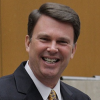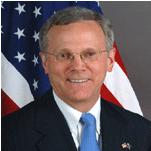Australia
Note: Also accredited to Nauru; resident at Canberra.
Note: Commissioned during a recess of the Senate; recommissioned after confirmation on Mar 2, 1949
Note: Not commissioned; nomination withdrawn before the Senate acted upon it.
Note: John R. Minter was serving as Chargé d'Affaires ad interim when Legation Canberra was raised to Embassy status, Jul 19, 1946
 Beazley, Kim
Beazley, Kim
A longtime Labor Party politician, Kim Christian Beazley has served as Australia’s ambassador to the United States since September 2009.
- Table of Contents
- News
- Overview
- Basic Information
- History
- Newspapers
- History of U.S. Relations with Australia
- Current U.S. Relations with Australia
- Where Does the Money Flow
- Controversies
- Human Rights
- Debate
- Past Ambassadors
- Ambassador to the U.S.
- Embassy Web Site in the U.S.
- Comments
- Leave a comment
U.S. Ambassador to Australia

The next ambassador to Australia will be a longtime federal administrator and Barack Obama supporter, who will also be the first openly gay envoy to the land down under. If confirmed by the Senate, Morrell John Berry, who goes by his middle name, would succeed Jeffrey Bleich, who served in Canberra starting in November 2009. Berry has been director of the Office of Personnel Management since April 2009.
Born February 10, 1959, Berry was raised in Rockville, Maryland. His mother, Alberta Opalko Berry, worked for the Census Bureau and his father, Morrell Joseph Berry, was an ex-Marine and moving company salesman. Berry, who has a brother and a sister, graduated from Good Counsel Catholic High School in 1977. He earned a B.A. in Government and Politics at the University of Maryland in 1980, and an M.P.A. at Syracuse University’s Maxwell School of Citizenship and Public Affairs in 1981, where he was a Herbert H. Lehman Fellow.
Berry started his career as a management intern for the Montgomery County, Maryland, government from 1982 to 1984, and served as the Maryland Senate Finance Committee staff director from 1984 to 1985. From 1985 until 1994, he worked as a staffer in the U.S. House of Representatives, first for the House Appropriations Committee and then as legislative director for Rep. Steny Hoyer (D-Maryland). During that time, he focused on federal employee issues, helping guide negotiations that led to the 1990 Federal Employees Pay Comparability Act, which established the locality pay system that adjusts wages according to the location of a job.
Following his Congressional work, Berry served at the Department of the Treasury in1994-1995 as deputy assistant secretary and acting assistant secretary for law enforcement, later assuming the role of assistant secretary for policy, management and budget.
Berry left Treasury in 1995 to serve as director of government relations and senior policy advisor at the Smithsonian Institution, where he helped secure federal funds for the National Museum of the American Indian and the National Air and Space Museum’s Hazy Center.
In 1997, Berry left the Smithsonian to become assistant secretary for policy, management and budget at the Department of the Interior, where he developed a presidential initiative known as the “Lands Legacy Initiative,” oversaw programs to improve employees’ work-life balance, and worked to make the Department a more just environment for gay and lesbian employees. In 1999, Berry was instrumental in adding to the National Register of Historic Places The Stonewall Inn in Greenwich Village, where, thirty years earlier, gay patrons had fought back against a homophobic police raid and launched the modern gay rights movement.
After President Bill Clinton left office in 2001, Berry became executive director of the National Fish and Wildlife Foundation, a congressionally chartered nonprofit dedicated to wildlife conservation.
In 2005, Berry returned to the Smithsonian to become director of the National Zoological Park, where he implemented a management reorganization, a 20-year capital master plan and secured funding for infrastructure improvements.
During his confirmation hearing for Assistant Secretary for Policy, Management and Budget in 1997, Berry said that both of his parents were Republicans. “We had an even partisan split around our dinner table—which was important in forging my appreciation that no one party holds the lock on truth, and my belief that the best decisions come from a search for common ground through well-intentioned debate.”
Nevertheless, Berry himself is a lifelong Democrat who has donated thousands of dollars to Democratic candidates over the years, including $7,800 to Barack Obama’s two presidential runs, $2,300 to Hillary Clinton’s 2009 campaign, and $4,000 to John Kerry’s 2004 presidential effort.
Berry lives with Curtis Yee, his partner of 12 years. In 1996, Berry’s companion of 11 years, Thomas Leishman, died of AIDS.
-Matt Bewig
To Learn More:
Gay Obama Nominee Succeeds as Values Turn on Rescuing Families (by Pat Wechsler and Aliza Marcus, Bloomberg)
Berry Sails Through Confirmation Hearing (by Ed O'Keefe, Washington Post)
morePrevious U.S. Ambassador to Australia

Note: Also accredited to Nauru; resident at Canberra.
Note: Commissioned during a recess of the Senate; recommissioned after confirmation on Mar 2, 1949
Note: Not commissioned; nomination withdrawn before the Senate acted upon it.
Note: John R. Minter was serving as Chargé d'Affaires ad interim when Legation Canberra was raised to Embassy status, Jul 19, 1946
 Beazley, Kim
Beazley, Kim
A longtime Labor Party politician, Kim Christian Beazley has served as Australia’s ambassador to the United States since September 2009.
Comments
U.S. Ambassador to Australia

The next ambassador to Australia will be a longtime federal administrator and Barack Obama supporter, who will also be the first openly gay envoy to the land down under. If confirmed by the Senate, Morrell John Berry, who goes by his middle name, would succeed Jeffrey Bleich, who served in Canberra starting in November 2009. Berry has been director of the Office of Personnel Management since April 2009.
Born February 10, 1959, Berry was raised in Rockville, Maryland. His mother, Alberta Opalko Berry, worked for the Census Bureau and his father, Morrell Joseph Berry, was an ex-Marine and moving company salesman. Berry, who has a brother and a sister, graduated from Good Counsel Catholic High School in 1977. He earned a B.A. in Government and Politics at the University of Maryland in 1980, and an M.P.A. at Syracuse University’s Maxwell School of Citizenship and Public Affairs in 1981, where he was a Herbert H. Lehman Fellow.
Berry started his career as a management intern for the Montgomery County, Maryland, government from 1982 to 1984, and served as the Maryland Senate Finance Committee staff director from 1984 to 1985. From 1985 until 1994, he worked as a staffer in the U.S. House of Representatives, first for the House Appropriations Committee and then as legislative director for Rep. Steny Hoyer (D-Maryland). During that time, he focused on federal employee issues, helping guide negotiations that led to the 1990 Federal Employees Pay Comparability Act, which established the locality pay system that adjusts wages according to the location of a job.
Following his Congressional work, Berry served at the Department of the Treasury in1994-1995 as deputy assistant secretary and acting assistant secretary for law enforcement, later assuming the role of assistant secretary for policy, management and budget.
Berry left Treasury in 1995 to serve as director of government relations and senior policy advisor at the Smithsonian Institution, where he helped secure federal funds for the National Museum of the American Indian and the National Air and Space Museum’s Hazy Center.
In 1997, Berry left the Smithsonian to become assistant secretary for policy, management and budget at the Department of the Interior, where he developed a presidential initiative known as the “Lands Legacy Initiative,” oversaw programs to improve employees’ work-life balance, and worked to make the Department a more just environment for gay and lesbian employees. In 1999, Berry was instrumental in adding to the National Register of Historic Places The Stonewall Inn in Greenwich Village, where, thirty years earlier, gay patrons had fought back against a homophobic police raid and launched the modern gay rights movement.
After President Bill Clinton left office in 2001, Berry became executive director of the National Fish and Wildlife Foundation, a congressionally chartered nonprofit dedicated to wildlife conservation.
In 2005, Berry returned to the Smithsonian to become director of the National Zoological Park, where he implemented a management reorganization, a 20-year capital master plan and secured funding for infrastructure improvements.
During his confirmation hearing for Assistant Secretary for Policy, Management and Budget in 1997, Berry said that both of his parents were Republicans. “We had an even partisan split around our dinner table—which was important in forging my appreciation that no one party holds the lock on truth, and my belief that the best decisions come from a search for common ground through well-intentioned debate.”
Nevertheless, Berry himself is a lifelong Democrat who has donated thousands of dollars to Democratic candidates over the years, including $7,800 to Barack Obama’s two presidential runs, $2,300 to Hillary Clinton’s 2009 campaign, and $4,000 to John Kerry’s 2004 presidential effort.
Berry lives with Curtis Yee, his partner of 12 years. In 1996, Berry’s companion of 11 years, Thomas Leishman, died of AIDS.
-Matt Bewig
To Learn More:
Gay Obama Nominee Succeeds as Values Turn on Rescuing Families (by Pat Wechsler and Aliza Marcus, Bloomberg)
Berry Sails Through Confirmation Hearing (by Ed O'Keefe, Washington Post)
morePrevious U.S. Ambassador to Australia








Comments